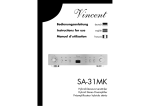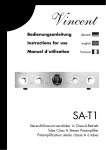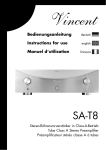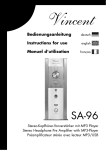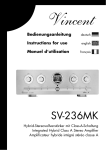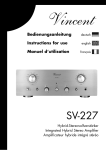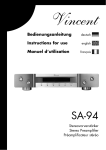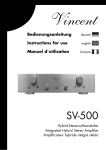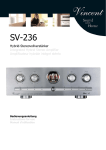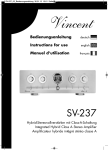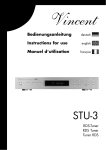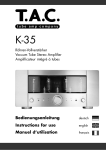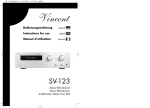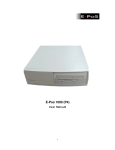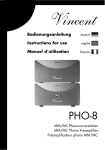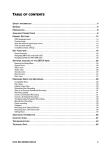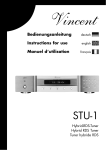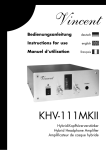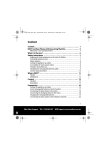Download VINCENT SA-31 Specifications
Transcript
Vincent Bedienungsanleitung deutsch Instructions for use english Manuel d‘utilisation français SA-31 Hybrid-Stereovorverstärker Hybrid Stereo Preamplifier Préamplificateur stéréo hybride Sehr geehrter Kunde, wir danken Ihnen für das Vertrauen, welches Sie uns durch die Entscheidung für dieses hochwertige AudioProdukt, das Ihrem hohen Anspruch an Klang- und Verarbeitungsqualität gerecht wird, entgegenbringen. Auch wenn Sie verständlicherweise sofort beginnen wollen, das Gerät zu verwenden, lesen Sie bitte vor dem Aufstellen und Anschließen dieses Handbuch sorgfältig durch. Es wird Ihnen bei der Bedienung und der optimalen Nutzung des Gerätes in Ihrem System helfen, selbst wenn dieses durch Ihren Fachhändler installiert wurde. Bitte beachten Sie vor allem die Sicherheitshinweise, auch wenn einige davon offensichtlich erscheinen mögen. Um Ihnen verwendete Fachbegriffe zu erläutern, ist ein kleines Lexikon im Anhang enthalten. Bei eventuellen Fragen steht Ihnen Ihr Fachhändler gern zur Verfügung, er ist auch Ihr Ansprechpartner im Fall der Garantie-Inanspruchnahme oder für Reparaturen nach dem Gewährleistungszeitraum. Er ist in jedem Fall interessiert daran, dass Sie ihm Ihre Erfahrungen mit Vincent-Produkten mitteilen. Viel Freude mit unserem / Ihrem Produkt wünscht Ihnen Ihr Vincent-Team INHALTSVERZEICHNIS/CONTENTS/SOMMAIRE Sicherheitshinweise Weitere Hinweise Lieferumfang Beschreibung des Gerätes Installation Bedienung des Gerätes Weitere Tipps Fehlertabelle Technische Daten Lexikon/Wissenswertes 4 5 6 6 9 13 14 15 16 17 deutsch Dear Customer, we thank you for the confidence you prove in purchasing our product. It will match your high demands towards sound and manufacturing quality. Though it is understandable that you want to plug and play this product instantaneously, we encourage you to read this manual carefully before installation. It will help you in handling and operating this machine in your system and obtaining the best possible performance, even if it was installed by your dealer. Please follow the security precautions, though some of those things may seem obvious. In the appendix to this manual you will find a glossary explaining some established technical terms. If there are open questions your audio specialist dealer will help you. He also represents your contact person in case of needed warranty service or repairs after the warranty period and is interested to hear from your experiences with Vincent products. We wish you plenty of joy with your / our product, your Vincent-Team Cher client, nous vous remercions de la confiance que vous nous témoignez en achetant ce produit de haute qualité. Il répondra à vos attentes élevées en termes de qualité sonore et de fabrication. Même si l'on peut comprendre que vous ayez envie d'utiliser immédiatement cet appareil, nous vous prions de lire soigneusement ce manuel avant son installation et son branchement. Il vous aidera à manier et utiliser l'appareil de manière optimale dans votre système, même si celui-ci a été installé par votre revendeur. Veuillez respecter les consignes de sécurité, même si certaines peuvent vous paraître évidentes. Vous trouverez à la fin de ce manuel un petit glossaire qui vous explique les termes techniques utilisés. Votre revendeur est à votre disposition pour répondre à vos questions. Il est aussi votre interlocuteur en cas de recours à la garantie ou pour les réparations après la période de garantie. Dans tous les cas, vos expériences avec les produits Vincent l'intéressent, n'hésitez pas à lui en faire part. Nous vous souhaitons beaucoup de plaisir avec notre / votre produit. Votre équipe Vincent Safety guidelines Other instructions Included in delivery Description of the appliance Installation Operating the appliance Tips Search for errors Technical specifications Glossary 18 19 20 20 23 27 28 29 30 31 english Consignes de sécurité Autres consignes Contenu de la livraison Description de l'appareil Installation Utilisation de l'appareil Conseils Résolution de problèmes Caractéristiques techniques Glossaire 32 33 34 34 37 41 42 43 44 45 français 2 Vincent Vincent 3 SICHERHEITSHINWEISE Dieses Gerät wurde unter strengen Qualitätskontrollen gefertigt. Es entspricht allen festgelegten internationalen Sicherheitsstandards. Trotzdem sollten folgende Hinweise vollständig gelesen und beachtet werden, um eine Gefährdung zu vermeiden: Das Gerät nicht öffnen! Gefahr des elektrischen Schocks! Es befinden sich keine vom Benutzer zu wartenden Teile im Gerät. Wartung/Veränderungen Alle Betriebsmittel, die an die Netzspannung des Haushalts angeschlossen sind, können dem Benutzer bei unsachgemäßer Behandlung gefährlich werden. Überlassen Sie die Wartung qualifiziertem Fachpersonal. Das Produkt ist nur für den Anschluss an 230Volt/50Hz Wechselspannung, für Schutzkontaktsteckdosen und die Verwendung in geschlossenen Räumen zugelassen. Durch Veränderungen im Gerät oder an der Seriennummer erlischt der Garantieanspruch. Lassen Sie die Gerätesicherung nach einem Fehlerfall nur von Fachpersonal durch ein Exemplar gleichen Typs ersetzen. Netzkabel/Anschluss Ziehen Sie stets den Netzstecker und nie am Netzkabel, wenn Sie die Verbindung zum Stromnetz trennen wollen. Stellen Sie sicher, dass beim Aufstellen des Gerätes das Netzkabel nicht gequetscht, extrem gebogen oder durch scharfe Kanten beschädigt wird. Fassen Sie das Netzkabel nicht mit nassen oder feuchten Händen an. Verwenden Sie das im Lieferumfang enthaltene oder andere Netzkabel von Vincent. Wasserdampf ist für diese Geräte und deren Benutzer gefährlich und unbedingt zu vermeiden. Achten Sie darauf, dass weder Flüssigkeiten noch Objekte in das Gerät gelangen (Lüftungsschlitze etc.). Es muss sofort vom Stromnetz getrennt und vom Fachmann untersucht werden, falls dies geschehen ist. Setzen Sie das Gerät nie hohen Temperaturen (Sonneneinstrahlung) oder starken Vibrationen aus. Wärmeentwicklung Achten Sie darauf, dass um das Gerät ein Abstand von 5 cm frei bleibt und die Umgebungsluft zirkulieren kann (keine Aufstellung in geschlossenen Schränken). Lüftungsöffnungen dürfen nicht verdeckt werden. Lautstärke Die maximal erträgliche Lautstärke wird stets weit unterhalb der maximal möglichen Einstellung am Verstärker erreicht. Gehen Sie deshalb vorsichtig mit der Lautstärkeeinstellung um, damit Hörschäden vermieden werden. Damit Sie sich nicht unbeabsichtigt hoher Lautstärke aussetzen, stellen Sie vor dem Wechsel des Eingangskanals stets einen niedrigen Wert ein. ON Ausschalten Schalten Sie das Gerät jedes Mal aus, bevor Sie andere Komponenten bzw. Lautsprecher anschließen oder entfernen, es vom Stromnetz trennen bzw. daran anschließen, es längere Zeit nicht benutzen oder dessen Oberfläche reinigen wollen. Warten Sie danach bei Vollverstärkern, Endstufen und Receivern ca. eine Minute, bevor Sie Kabelverbindungen trennen bzw. herstellen. OFF Reinigen Ziehen Sie vor dem Reinigen der Außenflächen des Produkts den Netzstecker. Verwenden Sie möglichst ein weiches, flusenfreies, angefeuchtetes Tuch. Verzichten Sie auf Scheuermittel, Lösungsmittel, Verdünner, entzündliche Chemikalien, Polituren und andere Reinigungsprodukte, die Spuren hinterlassen. WEITERE HINWEISE Aufstellen des Gerätes Die Art der Aufstellung der Anlage hat klangliche Auswirkungen. Stellen Sie diese deshalb nur auf eine dafür geeignete, stabile Unterlage. Um das Klangpotential Ihres Systems optimal auszunutzen, empfehlen wir, die Geräte auf Vincent Racks zu platzieren und nicht aufeinander zu stellen. Elektronik Altgeräte Dieses Gerät unterliegt den in der europäischen Richtlinie 2002/96/EC festgelegten Bestimmungen, deren gesetzliche Umsetzung in Deutschland durch das Elektro- und Elektronikgeräte-Gesetz (ElektroG) geregelt ist. Dies ist durch das Symbol eines durchgestrichenen Abfalleimers auf dem Gerät gekennzeichnet. Für Sie als Endverbraucher bedeutet das: Alle nicht mehr verwendeten Elektro- und Elektronik-Altgeräte müssen getrennt vom Hausmüll über dafür staatlich vorgesehene Stellen entsorgt werden. Damit vermeiden Sie Umweltschäden und helfen mit, die Hersteller zur Produktion von langlebigen oder wieder verwendbaren Produkten zu motivieren. Weitere Informationen zur Entsorgung des alten Gerätes erhalten Sie bei der Stadtverwaltung, dem Entsorgungsamt oder dem Geschäft, in dem Sie das Produkt erworben haben. CE-Zeichen Dieses Gerät erfüllt die gültigen EU-Richtlinien zur Erlangung des CE-Zeichens und entspricht damit den Anforderungen an elektrische und elektronische Geräte (EMV-Richtlinien, Sicherheitsrichtlinien und den Richtlinien für Niederspannungsgeräte). Erklärungen/Hinweise Dieses Dokument wurde verfasst von Andreas Böer. Es ist ein Produkt der Sintron Vertriebs GmbH, 76473 Iffezheim und darf ohne ausdrückliche und schriftliche Genehmigung weder komplett noch auszugsweise kopiert oder verteilt werden. Vincent ist ein eingetragenes Warenzeichen der Sintron Vertriebs GmbH, 76473 Iffezheim. Vincent arbeitet ständig an der Verbesserung und Weiterentwicklung seiner Produkte. Deshalb bleiben Änderungen an Design und technischer Konstruktion des Gerätes, sofern sie dem Fortschritt dienen, vorbehalten. Der Inhalt dieser Anleitung hat lediglich Informationscharakter. Er kann jederzeit ohne vorherige Ankündigung geändert werden und stellt keine Verpflichtung seitens des Markeninhabers dar. Dieser übernimmt keinerlei Verantwortung oder Haftung für Fehler oder Ungenauigkeiten, die möglicherweise in dieser Bedienungsanleitung enthalten sind. Aufbewahren der Verpackung Wir empfehlen Ihnen ausdrücklich, nach Möglichkeit die Originalverpackung für spätere Transportzweck aufzubewahren. Transportschäden treten bei ungeeignet verpackten HiFi-Geräten häufig auf. Dadurch, dass die Originalverpackung exakt zum Gerät passt, wird das Risiko einer Beschädigung während eines notwendigen Transportes gemindert. Erläuterung der grafischen Symbole Der Blitz weist Sie darauf hin, dass im Gerät gefährliche Spannungen vorhanden sind, die einen Stromschlag verursachen können. Das Ausrufezeichen macht Sie auf besonders wichtige Hinweise bezüglich Bedienung und Wartung aufmerksam. Der Zeigefinger kennzeichnet nützliche Informationen und Hinweise für den Umgang mit dem Gerät. Feuchtigkeit/Hitze/Vibrationen Der Kontakt elektrisch betriebener Geräte mit Flüssigkeiten, Feuchtigkeit, Regen oder 4 Vincent Vincent 5 LIEFERUMFANG VORDERANSICHT Bitte prüfen Sie den Inhalt der Verpackung, diese sollte folgende 5 Komponenten enthalten: • 1 Netzkabel • Zwei Cinchkabel für die Verbindung zwischen Vorverstärker und Endverstärker • dieses Handbuch 1 BESCHREIBUNG DES GERÄTES Obwohl die Entwicklung stetig in Richtung digitaler Tonformate und mehrkanaliger Audio-VideoSysteme geht, erfreuen sich hochwertige Stereoanlagen weiterhin großer Beliebtheit. Aktuelle Trends haben auch nichts an den Vorteilen getrennter Vorstufen-Endstufen-Systeme gegenüber integrierten Verstärkern geändert. Der SA-31 ist eine vielseitige und robuste StereoVorstufe aus dem Programm von Vincent. Um HighEnd-Stereotechnik auch in niedrigen Preisregionen anbieten zu können, wurde bei der Konzeption des Gerätes ein neuer Weg beschritten: anstatt klangbestimmende, hochwertige Bauelemente durch preisgünstigere zu ersetzen, wurde die Funktionalität des Gerätes reduziert. Ergebnis ist ein Verstärker, der sich mit seinen „größeren Brüdern“ klanglich mes- 6 Vincent sen kann und dafür auf Dinge verzichtet, welche die Klangqualität nicht positiv beeinflussen: Fernbedienung, große Zahl an Eingangskanälen, Balanceregelung und Stummschaltung. Die Schaltung der Vorstufe verbindet die Vorzüge von Class-A-Tansistorverstärkern und Röhrenverstärkern. Höchste Verarbeitungsqualität und ein hervorragendes Preis-Leistungs-Verhältnis sind selbstverständlich. Dieser Vorverstärker ist der ideale Partner für die Endstufen SP-331/SP-331mk sowie für DVDPlayer, CD-Player, Tuner, Kopfhörerverstärker und Lautsprecher von Vincent. Zusammen mit den HiFiMöbeln und Lautsprecherkabeln des Sortiments kann ein perfekt harmonierendes System aufgebaut werden. 2 3 1. TREBLE: Höhenregler Zur Einstellung der Höhenanteile des Klangs. 2. TONE: Klangregelung ein-/ausschalten Umgehung (Bypass) der Klangregelung (Abschalten der TONE-Funktion). 3. BASS: Tiefenregler Zur Einstellung der Bassanteile des Klangs. 4. POWER: Netzschalter Schaltet das Gerät ein und aus, das Gerät ist im ausgeschalteten Zustand vom Netz getrennt. 4 6 7 8 5. LED „POWER“: Betriebskontrollleuchte Leuchtet, während das Gerät eingeschaltet und betriebsbereit ist. 6. INPUT: Drehknopf für die Eingangswahl Hiermit kann die Eingangsquelle ausgewählt werden. 7. LOUD: Loudness-Schaltung Dieser Knopf aktiviert und deaktiviert eine Klangkorrektur für niedrige Lautstärkebereiche. 8. VOLUME: Lautstärkedrehknopf Hiermit kann die Lautstärke des Systems erhöht oder verringert werden. Vincent 7 RÜCKANSICHT INSTALLATION Stellen Sie die Kabelverbindung in der nachfolgend genannten Reihenfolge her. Bringen Sie erst zuletzt das Netzkabel an und verbinden es mit der Steckdose. ZUR BESONDEREN BEACHTUNG Entfernen der Schutzkappen Vor der ersten Installation müssen von allen verwendeten Anschlüssen an der Geräterückseite die Kunststoff-Schutzkappen entfernt werden. 1 9 10 11 12 2 Cinch-Anschlüsse Als Steckverbinder für Ein- und Ausgänge sind mechanisch identische Cinch-Buchsen vorhanden. Achten Sie darauf, dass Sie diese Anschlüsse bei der Installation nicht verwechseln! 13 OU TP U TOU 8 9. INPUT: Anschluss von StereoQuellgeräten mit Hochpegelausgang Vier Stereo-Cinch-Eingangsanschlüsse für Quellgeräte mit analogem Stereoton-Hochpegelausgang. 11. OUTPUT: Vorverstärkerausgänge Über diese zwei Anschluss-Paare wird das vorverstärkte Stereo-Tonsignal der momentan gewählten Quelle an die Endstufenkanäle weitergegeben. 10. REC OUT: Aufnahmeausgang Schließen Sie hier, wenn gewünscht, z.B. ein Aufnahmegerät an. Das Stereo-Signal dieses Ausganges ist mit dem Ausgangssignal der momentan gewählten Quelle an einem der „INPUT“-Anschlüsse identisch. 12. FUSE: Sicherungshalter Dieses kleine Kunststoff-Gehäuse beinhaltet die Gerätesicherung. Beachten Sie dazu die Sicherheitshinweise. Vincent 13. AC IN: Netzbuchse Bringen Sie hier das Netzkabel an und verbinden Sie es mit der Stromversorgung. Kabel und Steckverbindungen Achten Sie darauf, dass alle Steckverbindungen fest sitzen. Unzureichende Anschlüsse können Störgeräusche, Ausfälle und Fehlfunktionen verursachen. - falsch - Achten Sie darauf, die analogen Eingänge für rechts und links nicht zu vertauschen. Häufig sind deren Cinch-Anschlüsse folgendermaßen farblich markiert: Rot für den rechten Kanal, schwarz oder weiß für den linken Kanal. - richtig - Um das Klangpotential der Komponenten voll auszuschöpfen, sollten nur hochwertige Lautsprecherund Verbindungskabel, beispielsweise Vincent Kabel, verwendet werden. Bevorzugen Sie geschirmte Audio-Kabel. Ihr Fachhändler wird Sie gern diesbezüglich beraten. Das Berühren des mittleren Kontaktstiftes des Cinch-Steckers mit dem äußeren Kontakt der CinchBuchse kann bei eingeschalteten Geräten im schlimmsten Fall zur Beschädigung der Geräte führen. Nehmen Sie deshalb niemals Änderungen an den Kabelverbindungen vor, während die Geräte eingeschaltet sind! Vincent 9 ANSCHLUSS DER QUELLGERÄTE ANSCHLUSS DES/DER ENDVERSTÄRKER Verbinden Sie die Ausgänge der Quellgeräte mit den Eingängen „CD“, „AV“, „TAPE“ und „TUNER“ (9) dieser Vorstufe. Es können bis zu vier Stereo-Quellen mit Cinch-Hochpegelausgang angeschlossen werden. Bei den Eingangsanschlüssen handelt es sich um elektrisch gleichwertige Hochpegeleingänge mit Cinch-Buchsen. Meist sind die Ausgangsanschlüsse der Quellgeräte mit „LINE OUT“, „AUDIO OUT“ oder „FRONT OUT“ markiert. Informationen über die Anschlussmöglichkeiten der Quellgeräte finden Sie in deren Bedienungsanleitungen. Es können bis zu vier Endstufenkanäle angeschlossen und somit auch entweder mehr als zwei Lautsprecher oder zwei Lautsprecher im Bi-Amping (z.B. mit zwei Stereo-Endstufen) betrieben werden. Die Endverstärker versorgen die Lautsprecher des Systems, die Lautsprecher werden an die Ausgänge der Endverstärker angeschlossen. Als Beispiel sind in diesem Abschnitt Stereo-Endverstärker abgebildet. Anstelle einer Stereo-Endstufe können natürlich auch zwei Mono-Endstufen zum Einsatz kommen. Cinch-Verbindung SA-31 CD-Player, Tuner, DVD-Player, etc. LINE OUT Anschluss eines Lautsprecherpaares: In diesem Fall benötigen Sie zwei Endstufenkanäle, so z.B. einen Stereo-Endverstärker. Verbinden Sie die beiden Buchsen des mit „1“ markierten Cinch-Paares im Anschlussfeld „OUTPUT“ mit den Cinch-Eingangsbuchsen der Endstufenkanäle (oft als „INPUT“ oder „POWER AMP IN“ bezeichnet). Achten Sie darauf, dass rechter und linker Kanal nicht vertauscht werden. Die Buchstaben „R“ und „L“ zeigen Ihnen die richtige Zuordnung. Der mit „2“ bezeichnete Vorstufenausgang der SA-31 kann zusätzlich für einen Kopfhörerverstärker verwendet werden. Cinch-Verbindung Allgemeine Hinweise: Zur Verwendung eines Plattenspielers benötigen Sie eine so genannte Phono-Vorstufe (auch EntzerrerVorstufe genannt), die im Signalweg zwischen Plattenspieler und einem der Hochpegeleingänge installiert wird. Einige Plattenspieler-Modelle enthalten bereits diese Vorstufe und können direkt angeschlossen werden. Weitere Informationen erhalten Sie in der Bedienungsanleitung dieses Gerätes. Oftmals lässt sich unter Zuhilfenahme von Adaptern auch der Stereo-Ton von Geräten nutzen, deren Line-Pegel-Ausgänge nicht über Cinch-Ausgangsbuchsen, sondern andere Steckverbinder (DINStecker, Klinkenstecker) angeschlossen werden. SA-31 INPUT z.B. Stereo-Endverstärker Cinch-Verbindung Diese Art der Endstufenverbindung ist auch zu wählen, wenn ein Lautsprecherpaar im Bi-Wiring angeschlossen werden soll. ANSCHLUSS EINES AUFNAHMEGERÄTES An die Cinch-Buchsen „REC OUT“ (10) auf der Rückseite des Gerätes können Sie, wenn gewünscht, ein analoges Stereo-Aufnahmegerät (z.B. CD-Recorder, Kassettenrecorder o.ä.) oder ein anderes Gerät, das den unveränderten, fest eingestellten Stereo-Ausgangspegel (Line-Pegel) der momentan an der Vorstufe gewählten Signalquelle erhalten soll, anschließen. Der Ausgangspegel ist unabhängig von Lautstärke- und Klangregelung (BASS, TREBLE, TONE, LOUD). SA-31 Cinch-Verbindung z.B. Kassettenrecorder LINE IN Verbinden Sie dazu diesen Signalausgang mittels Cinch-Kabel mit dem Signaleingang („LINE IN“, „TAPE IN“ oder „REC IN“) des Aufnahmegerätes. Beachten Sie bitte, dass einige Aufnahmegeräte einen geringfügig störenden Einfluss auf das jeweilige Audiosignal haben können. Manche Aufnahmegeräte haben eine eher niedrige Eingangsimpedanz, welche die Musiksignalspannung in geringem Maße verringern kann. Für maximalen Musikgenuss empfehlen wir Ihnen, die Verbindung an den „REC“-Buchsen nur so lange anzuschließen, wie Sie Aufnahmen durchführen. 10 Vincent Vincent 11 ANSCHLUSS DES/DER ENDVERSTÄRKER Anschluss zweier Lautsprecherpaare: In diesem Fall werden vier Endstufenkanäle benötigt, so z.B. zwei Stereo-Endverstärker. Verbinden Sie die beiden Buchsen des mit „1“ markierten Cinch-Paares im Anschlussfeld „OUTPUT“ des Vorverstärkers wie gewohnt mit den Cinch-Eingangsbuchsen der Endstufenkanäle für das erste Lautsprecherpaar. Verbinden Sie nun zusätzlich die beiden Buchsen des mit „2“ markierten Cinch-Paares im Anschlussfeld „OUTPUT“ der SA-31 mit den Cinch-Eingangsbuchsen der Endstufenkanäle für das zweite Lautsprecherpaar. Die Eingangsanschlüsse der Vorverstärker sind oft als „INPUT“ oder „POWER AMP IN“ beschriftet. Achten Sie darauf, dass rechter und linker Kanal nicht vertauscht werden. Die Buchstaben „R“ und „L“ zeigen Ihnen die richtige Zuordnung. Ihr Fachhändler wird Ihnen gern bei der Installation behilflich sein. Cinch-Verbindung INPUT SA-31 INPUT Cinch-Verbindung z.B. Stereo-Endverstärker z.B. Stereo-Endverstärker Diese Art der Endstufenverbindung ist auch zu wählen, wenn ein Lautsprecherpaar im Bi-Amping angeschlossen werden soll. Dabei müssen zwei zusätzliche Endstufenkanäle zur Verfügung stehen, beispielsweise eine zweite Stereo-Endstufe. ANSCHLUSS DES NETZKABELS Prüfen Sie, ob die Stromversorgung Ihres Haushalts für das Gerät geeignet ist. Benötigte Spannung und Frequenz sind auf der Geräterückseite neben der Netzbuchse abzulesen. Wenn die Stromversorgung geeignet ist, drücken Sie den Kaltgerätestecker des mitgelieferten Netzkabels fest in die Netzbuchse an der Geräterückwand. Verbinden Sie das andere Ende des Netzkabels mit einer Netzsteckdose. 12 Vincent BEDIENUNG DES GERÄTES Aktion Ein- und Ausschalten Eingangsquelle wählen Lautstärke des Systems verändern Höhenanteile des Klangs verändern Bassanteile des Klangs verändern Klangregelung (BASS/TREBLE) abschalten Klangbearbeitung für niedrige Lautstärke Taste(n) Beschreibung POWER (4) Das Gerät wird an der Gerätevorderseite ein- und ausgeschaltet. Ist der Schalter in der Ausschaltposition, ist das Gerät vom Stromnetz getrennt. Vor dem Einschalten sollte vorsichtshalber die Lautstärkeeinstellung der Vorstufe reduziert werden. Im eingeschalteten Zustand leuchtet die oberhalb des Schalters angeordnete LED. INPUT (6) Durch Drehen des Knopfes für den gewünschten Eingangskanal (INPUT) wird zur Wiedergabe des an den entsprechenden Eingangsbuchsen (9) angeschlossenen Gerätes gewechselt. Vor dem Umschalten des Eingangskanals sollte vorsichtshalber die Lautstärke (8) reduziert werden! Drehen Sie den Knopf „VOLUME“ im Uhrzeigersinn, um die Lautstärke des Systems zu erhöhen oder im Gegenuhrzeigersinn, um diese zu verringern. VOLUME (8) Die Lautstärkeeinstellung hat keinen Einfluss auf das Signal am Ausgang „REC OUT“ (10). Das Gerät besitzt keine Taste zur Lautstärkestummschaltung. TREBLE (1) Mit dem Drehregler „TREBLE“ beeinflussen Sie den Anteil der höheren Töne des Klangbilds. Drehung im Uhrzeigersinn verstärkt die eingestellte Intensität, Bewegung im Gegenuhrzeigersinn verringert die Intensität. Die Einstellung wird nur wirksam, wenn der „TONE“-Knopf (2) nicht gedrückt ist. Auf das Signal des Ausgangs „REC OUT“ (10) hat die Einstellung keinen Einfluss. BASS (3) Mit dem Drehregler „BASS“ beeinflussen Sie den Anteil der tieferen Töne des Klangbilds. Drehung im Uhrzeigersinn verstärkt die eingestellte Intensität, Bewegung im Gegenuhrzeigersinn verringert die Intensität. Die Einstellung wird nur wirksam, wenn der „TONE“-Knopf (2) nicht gedrückt ist. Auf das Signal des Ausgangs „REC OUT“ (10) hat die Einstellung keinen Einfluss. TONE (2) Soll der Klang nicht verändert werden, empfiehlt es sich, die Klangregelung (BASS, TREBLE) mit diesem Knopf abzuschalten. Wenn der Knopf gedrückt ist, ist die an den Klangreglern (1)(3) eingestellte Klangbearbeitung wirksam. Wenn der Knopf nicht gedrückt ist, werden die beiden Klangregler in der Vorstufe umgangen und die Signale werden unverändert verstärkt. LOUD (7) Die Loudness-Funktion wird mit diesem Knopf an der Gerätevorderseite betätigt. Sie ist ein Leistungsmerkmal von Audio-Verstärkern, das es dem Bediener ermöglicht, per Knopfdruck tiefe und hohe Frequenzen anzuheben. Die Loudness-Funktion korrigiert damit den Lautstärkeeindruck bei niedriger Lautstärke. Dies ist notwendig, weil das menschliche Gehör bei niedriger Lautstärke hohe und tiefe Frequenzanteile bei identischem Schalldruck viel leiser wahrnimmt als die Mitten (Tonfrequenzen um 1 kHz). Diese Funktion sollte nur bei niedriger Lautstärke verwendet werden. Sie hat keinen Einfluss auf das Signal am Ausgang „REC OUT“ (10). Vincent 13 WEITERE TIPPS Einspielzeit / Aufwärmen Ihre Audio-Geräte benötigen eine gewisse Zeit bis sie ihre klangliche Höchstleistung erreichen. Dieser Zeitraum ist für die verschiedenen Komponenten Ihres Systems sehr unterschiedlich. Bessere und gleichförmigere Leistung erhalten Sie während der Zeit, die das Gerät eingeschaltet bleibt. Nutzen Sie die Erfahrung Ihres Fachhändlers! Netzbrummen Bestimmte Quellgeräte können im Verbund mit dem Verstärker zu einem über die Lautsprecher hörbaren Brummgeräusch führen, dessen Lautstärke sich mit dem Lautstärkeregler beeinflussen lässt. Dies ist kein Hinweis auf einen Mangel eines Ihrer Audio-Produkte, muss aber durch entsprechende Maßnahmen verhindert werden. Generell kann jedes an den Verstärker angeschlossene, ebenfalls netzbetriebene und mit dem Schutzleiter des Stromnetzes verbundene Gerät dieses Problem hervorrufen. Dieses Phänomen wird erfahrungsgemäß entweder durch den Antennenanschluss des Tuners bzw. Fernsehers oder in Verbindung mit Personalcomputern, elektrostatischen Lautsprechern, Subwoofern, Plattenspielern oder Kopfhörerverstärkern hervorgerufen, sofern eine Audioverbindung zum Verstärker besteht. 14 Vincent Eine weitere mögliche Quelle für Brummstörungen stellt die elektromagnetische Einstrahlung des Netzteiles anderer Geräte (z.B. Verstärker, Receiver, CD-Player, Tuner usw.) auf das Tonabnehmersystem eines angeschlossenen Plattenspielers dar. Solche Fehlerursachen kann man leicht selbst ermitteln, indem man die Aufstellung des Plattenspielers gegenüber den anderen Geräten verändert. Das Massepotential aller Signale ist in fast jedem elektrischen Gerät an einem zentralen Punkt zusammengefasst. Dort finden sie genau einmal eine gemeinsame Verbindung. Sollte ein Schutzleiter vorhanden sein, hat er immer an einer strategisch günstigen Stelle eine unlösbare Verbindung mit dem Gehäuse und beide werden meist auch genau einmal am zentralen Massepunkt mit angeschlossen. So wird auch die abschirmende Wirkung des Gehäuses erzeugt. Manche Geräte besitzen einen Masse-Trennschalter (GND SWITCH) an der Geräterückseite. Wenn dieser eingeschaltet ist (sich in der Position „ON“ befindet), sind Schutzleiter und Gehäuse gemeinsam vom Massepunkt abkoppelt, die Schutzleiterwirkung bleibt erhalten. Ist das Brummgeräusch durch eigene Versuche nicht zu beseitigen, wird Ihnen Ihr Fachhändler weiterhelfen. FEHLERSUCHE Symptom Mögliche Fehlerursache Abhilfe Keine Funktion nach Betätigung des Netzschalters Netzkabel nicht an eine betriebsbereite Steckdose angeschlossen. Stellen Sie eine Verbindung zu einer funktionierenden Steckdose mit der geeigneten Netzspannung her. Netzkabel nicht fest in die Steckdose und die Gerätebuchse gesteckt oder defekt. Prüfen Sie das Netzkabel, tauschen Sie es gegebenenfalls gegen ein geeignetes Kaltgerätekabel aus und drücken Sie dessen Stecker fest in die Steckdose und auf der anderen Seite in die Netzbuchse des Gerätes. Gerätesicherung oder Gerät ist defekt. Kontaktieren Sie Ihren Fachhändler. Das momentan eingestellte (6) Quellgerät gibt kein Signal aus. Starten Sie die Wiedergabe der angeschlossenen Signalquelle. Eine der Audio-Einstellungen eines angeschlossenen DVD-Players (analog/digital) ist nicht richtig gewählt. Korrigieren Sie die Einstellungen im Setup des Players. Ausgang des Quellgerätes nicht oder falsch bzw. nicht mit dem gewünschten Eingangsanschluss des Vorverstärkers verbunden. Korrigieren Sie den Anschluss der Signalquelle. Falscher Eingangskanal am Vorverstärker gewählt. Korrigieren Sie die Eingangswahl (6). Lautstärke (VOLUME) zu niedrig eingestellt. Erhöhen Sie vorsichtig die Lautstärke (8). Endstufe(n) wurde(n) nicht richtig an den Vorverstärker angeschlossen, ist/sind ausgeschaltet oder defekt. Prüfen Sie Anschluss, Betriebsbereitschaft und Funktionsfähigkeit des/der Endverstärker(s). Die Lautsprecherkabel sind nicht richtig mit den Anschlussklemmen des Endverstärkers verbunden oder defekt. Prüfen und befestigen Sie die Lautsprecherkabel an den Klemmen des Endverstärkers und an den Lautsprecheranschlüssen. Kein Ton, obwohl Gerät eingeschaltet und betriebsbereit ist (LED „POWER“ leuchtet) Vincent 15 FEHLERSUCHE LEXIKON/WISSENSWERTES Symptom Mögliche Fehlerursache Abhilfe Ton-Wiedergabe eines Kanals funktioniert nicht Das Quellgerät gibt nur auf einem Kanal ein Signal aus. Prüfen Sie das Quellgerät, z.B. an einem anderen Verstärker. Eines der Signalkabel zwischen Quellgerät und Vorverstärker ist nicht fest eingesteckt oder defekt. Prüfen und befestigen Sie diese Kabel. Ein oder mehrere Audiosignalkabel zwischen Vorstufe und Endverstärker sind defekt oder die Steckverbindungen lose. Prüfen und befestigen Sie diese Kabel. Audio-Quellen/Audio-Quellgeräte Komponenten Ihrer HiFi-Anlage und alle weiteren Geräte, deren Ton Sie über das System hören möchten und dazu an den Vor-, Vollverstärker oder Receiver anschließen. Dazu gehören CD-Player, DVD-Player, Tuner (Radios), Kassettenspieler, DATRecorder, Personalcomputer, Schallplattenspieler, portable Audiogeräte und viele weitere. Eines der Lautsprecherkabel ist nicht richtig an die Endstufe angeschlossen oder defekt. Prüfen und befestigen Sie die Lautsprecherkabel an den Klemmen des Endverstärkers und an den Lautsprecheranschlüssen. Dynamik Unterschied zwischen den leisesten und dem lautesten Tönen, die in Audio-Signalen (ohne Verzerrungen oder Übergang in Rauschen) möglich sind. Anschlüsse der Kabelverbindungen sind lose, die Anschlüsse verschmutzt oder ein Kabel defekt. Prüfen Sie die Audio-Anschlüsse. Die Klangeinstellungen an den Knöpfen „TREBLE“, „BASS“ oder „LOUD“ sind nicht richtig gewählt. Prüfen Sie die dort gewählten Einstellungen. Ein Plattenspieler wurde ohne zwischengeschaltete Entzerrervorstufe (Phonovorstufe) an einen der Hochpegeleingänge angeschlossen. Schließen Sie eine Phonovorstufe im Signalweg zwischen Plattenspieler und Vorverstärker an. Schlechte Tonqualität Tiefton- Brummen zu hören Siehe Abschnitt „Netzbrummen“ im Kapitel „Weitere Tipps“. Eingangsempfindlichkeit Begriff für die kleinste Eingangsspannung, die bei maximaler Lautstärkeeinstellung des Verstärkers die maximale Ausgangsleistung bewirkt. Beispiele: 100 mV bis 500 mV (Millivolt) bei Hochpegeleingängen, 2 mV bis 5 mV am Phono-MM-Eingang oder 0,1 mV bis 0,5 mV am Phono-MC-Eingang. Pegel Eine Art der Darstellung jeder physikalischen Größe; gebräuchliches Maß für Signalspannungen und Lautstärke. Wird in Dezibel (dB) angegeben. Als Spannungen „auf Line-Pegel“ werden Signalspannungen unterhalb 1V bezeichnet, die als Musik-Signale für Verstärker-Eingänge geeignet sind. Eingänge des Verstärkers (in der Regel als CinchBuchse ausgeführt), die für Signale des CDPlayers, Tape-Recorders, DVD-Players usw. vorgesehen sind, werden auch als „Line-Level-Eingänge“ oder „Hochpegel-Eingänge“ bezeichnet. RCA/Cinch RCA ist die amerikanische Bezeichnung für die koaxialen Cinch-Steckverbindungen als Abkürzung für „Radio Corporation of America“, den Namen einer US-amerikanischen Firma. Sowohl Stecker als auch verwendete Kabel bestehen aus einem stabförmigen Innenleiter und einem zylinderhüllenförmigen Außenleiter. Damit lässt sich ein Mono-Audiosignal oder ein Videosignal übertragen. Im Vergleich mit der XLR-Steckverbindung wird diese Verbindungsart auch „unsymmetrische Signalverbindung“ („unbalanced“) genannt. TECHNISCHE DATEN Frequenzgang: Nenn-Ausgangsspannung: Klirrfaktor: Eingangsempfindlichkeit: Signal-Rausch-Abstand: Eingangsimpedanz: Netzanschluss: Eingänge: Ausgänge: Maße: Gewicht: Farbe: Röhren: 16 Vincent 20 Hz - 20 kHz ±0,5 dB 2V < 0,1% (1 kHz, 1 W) 150 mV > 90 dB 47 kΩ 230 V/50 Hz 4 x Cinch stereo (LINE IN) 2 x Cinch stereo (PRE OUT) 1 x Cinch stereo (REC OUT) 430 x 80 x 300 mm 4,5 kg silber / schwarz 2x 6N16B Vincent 17 SAFETY GUIDELINES This appliance was produced under strict quality controls. It complies with all established international safety standards. Nonetheless, the following instructions should be fully read and observed in order to prevent any hazard: Do not open the appliance! Risk of electric shock! There are no parts in the appliance that require maintenance by the user. Maintenance/Alterations All equipment that is connected to the domestic mains voltage can be dangerous to the user if not handled properly. Leave maintenance work to qualified professionals. The product is only permitted for connection to AC 230Volt/50Hz, for earthed sockets and use in enclosed areas. Altering the product or manipulating its serial number voids the warranty. After a fault, leave the appliance’s fuse to be replaced only by a professional with one of the same kind. Power Cable Connection Always pull the plug and never the power cable if you want to disconnect the appliance from the mains power. Make sure when setting up the appliance that the power cable is not squashed, severely bent or damaged by sharp edges. Do not touch the power lead with wet or damp hands. Use the power cable supplied or another one from Vincent. ON Switching Off Switch the appliance off every time before you connect or remove other components or loudspeakers, disconnect or connect it to the mains power, leave it unused for a longer period or want to clean its outside. On all amplifiers and receivers, wait approx. 1 minute after this before disconnecting or reconnecting the cable. ded without fail. Take care that no liquids or objects get inside the appliance (ventilation slots etc.). It must be disconnected from the mains power immediately and examined by a professional if this happens. Never expose the appliance to high temperatures (direct sunshine) or strong vibration. Heat Build-up Make sure that a gap of 5 cm remains around the appliance and that the surrounding air can circulate (do not install in enclosed cupboards). Vents must not be covered up. Volume The maximum tolerable volume is always reached well below the maximum possible setting on the amplifier. Be careful with the volume setting, therefore, in order to prevent damage to hearing. So that you do not expose yourself to high volumes unintentionally, always set to a low level before changing the input channel. OFF Moisture/Heat/Vibration Contact of electrically operated equipment with liquids, moisture, rain or water vapour is dangerous for such equipment and the user and must be avoi- 18 Vincent Cleaning Pull out the power plug before cleaning the outside of the product. Whenever possible, use a soft, lintfree cloth that has been dampened. Do not use abrasives, solvents, thinners, flammable chemicals, polishes and other cleaning products that leave marks. OTHER INSTRUCTIONS Setting up the appliance How the system is set up has an effect on the sound quality. Therefore only place it on a suitable, stable surface. To make the most of your system’s sound quality, we recommend placing the equipment on Vincent racks and not putting them on top of each other. Old electronic equipment This appliance is subject to the conditions set out in the European Directive 2002/96/EC. This is identified by the symbol of a crossed out waste bin on the appliance. What this means for you as a consumer: All old electrical and electronic equipment that is no longer used must be disposed of separately from domestic waste using places provided by the authorities. By doing so you can prevent damage to the environment and help to encourage manufacturers to produce more durable or reusable products. For further information about disposing your old appliance, please consult your local authority, waste disposal agency or the shop where you bought the product. CE sign This appliance complies with the current EU directives about attaining the CE mark and thus meets the requirements for electrical and electronic equipment (EMC regulations, safety regulations and regulations for low voltage equipment). Declarations This document was written by Andreas Böer. It is a product of Sintron Vertriebs GmbH, 76473 Iffezheim and may not be copied or distributed partly or in full without express, written consent. Vincent is a registered trademark of Sintron Vertriebs GmbH, 76473 Iffezheim. Vincent works continually to improve and develop its products. Therefore, the appearance and technical design of the appliance are subject to changes, as long as they are in the interest of progress. The content of these instructions is for information purposes only. It can be changed at any time without prior notice and does not constitute any obligation on the part of the trademark’s owner. The latter assumes no responsibility or liability for errors or inaccuracies, which may be included in these operating instructions. Storage of the packaging We strongly recommend that you keep the original packaging in case you need to transport the equipment again at a later date. Transport damages are mainly caused by improper packaging of the HiFidevices. Because the original packaging fits the equipment accurately it will reduce the risk of damage if transport is necessary. Explanation of the symbols The lightening bolt tells you that dangerous voltages are present in the appliance, which can cause an electric shock. This symbol brings your attention to particularly important information regarding operation and maintenance. This symbol identifies useful information and advice about how to handle the appliance. Vincent 19 INCLUDED IN DELIVERY FRONT VIEW 5 Please check the contents of the packaging, which in addition to the appliance should contain the following accessories: • 1 power cable • 1 stereo set of RCA cables to connect the main amplifier • this manual 1 DESCRIPTION OF THE APPLIANCE Despite the fact that development is constantly moving in the direction of digital audio format and towards audio video systems with an increasing number of channels, high quality stereo systems still enjoy a large degree of popularity. Recent trends also have not brought any changes concerning the advantages of separate pre/main amplifier systems over integrated amplifiers. The SA-31 is a multi-purpose and sturdy stereo preamplifier within the Vincent range. In order to also offer the high-end stereo technology at a lower price level, new ground has been broken during the design of the appliance: instead of replacing sound regulatory and high quality components by more competitive parts, the functions of the appliance have been adjusted. The outcome is an amplifier that, in terms of sound quality, is 20 Vincent able to compete with its “big brothers” and in return it comes without functions that do not positively affect the sound quality: remote control, large number of input channels, BALANCE control and MUTE function. The amplifier circuitry of this preamplifier combines the advantages of both transistor amplifiers and valve amplifiers. The highest manufacturing quality and excellent value for money go without saying. This preamplifier is also the ideal partner for the main amplifiers SP-331/SP-331MK as well as DVD players, CD players, tuners, headphone amplifiers and loudspeakers from the Vincent range. In combination with the HiFi furniture and speaker cables from the range, one can build a perfectly harmonious system. 2 3 1. TREBLE Knob for setting the treble proportions (high frequencies) of the sound. 2. TONE If deactivated, audio signals bypass the tone control that has been set with the BASS and TREBLE dials. 3. BASS Knob for setting the bass proportions (low frequencies) of the sound. 4. POWER This is the main power switch for turning on and off the device. The preamplifier is separated from the mains voltage when switched off and cannot be set into a standby state. 4 6 7 8 5. LED “POWER” This LED is blinking as long as the tubes are being warmed up. It remains illuminated while the appliance is switched on and operational. 6. INPUT: Input Selector This dial allows you to choose one of the four inputs (named TUNER, TAPE, AV and CD). 7. LOUD: Loudness function This button activates and deactivates an audio signal correction that adapts the speaker audio signal to the human auditory sensation in the lower volume range. 8. VOLUME: Volume dial This is the knob for the adjustment of the main volume level of the system. Vincent 21 REAR VIEW INSTALLATION Set up the cable links in a sequence as follows. Connect the power cable between device and power supply only after all other connections have been made. DURING INSTALLATION PLEASE OBSERVE THE FOLLOWING ADVICE: 9 10 11 12 13 9. INPUT: Terminal for stereo audio signals of the source equipment Here you find four stereo RCA input sockets for source equipment with analogue stereo (line level) audio output. 11. OUTPUT: preamplifier outputs With these two pairs of connectors you can connect the preamplified stereo audio signal of the currently selected source to the power amplifier channels. 10. REC OUT: Output connectors assigned to a recording device If desired, you can connect a recording device like a CD recorder or a tape recorder to this output. The stereo signal of this output is identical to the output signal of the selected audio source at one of the preamplifier inputs. 12. FUSE: Fuse holder This small plastic housing holds the fuse. Refer to the security precautions. Protective caps Prior to the first installation the protective plastic caps must be removed from all the connections used at the rear of the unit. 1 2 Cable connections Make sure that all plugs fit tightly. Inadequate connections can cause noise interference, failures and malfunctions. OU TP U TOU RCA connections Mechanically identical RCA plugs are available for analogue and digital outputs. Make sure that you do not get these connections confused during installation! Make sure that you do not mix up the analogue connectors for right and left. The RCA plugs for these are mostly colour coded as follows: red for the right channel, black or white for the left channel. - wrong - - correct - To make the most of the components’ sound potential, only high quality loudspeakers and connecting cables, for example Vincent cables, should be used. Your local stockist will be glad to advise you about this. 13. AC: Power Connector To establish the power supply, connect the plugs of the power cable to the device and to a suitable wall outlet. Contacting the middle pin of the RCA plugs with the outer ring of the RCA chassis jack may lead to damages to the main amplifier if it is switched on! To avoid this hazard, connect or disconnect only in switched-off state and more than one minute after deactivating! 22 Vincent Vincent 23 CONNECTION OF THE SOURCE EQUIPMENT CONNECTION OF ONE OR MORE POWER AMPLIFIERS You can connect up to four devices with analogue stereo high level output such as a CD player in order to provide the audio signals of your input sources to the system. The output sockets on the source equipment are usually indicated by “Line Out”, “Audio Out” or “Front Out”. You will find information about ways to connect source equipment in their operating manuals. The audio inputs “CD”, “AV”, “TAPE” and “TUNER” (9) represent electrically equivalent standard high level inputs with RCA connection. They have an identical function and differ only in name. This preamplifier has two stereo preamplifier outputs with RCA connectors for the main amplifier channels. In this way it is possible to drive four loudspeakers or bi-wire/bi-amp one pair of loudspeakers. The main amplifiers supply the system’s loudspeakers and the loudspeakers are connected to the outputs of these. Instead of each stereo main amplifier shown here you can alternatively use two mono main amplifiers. RCA connection SA-31 CD player, tuner, DVD player, etc. LINE OUT Connection of one pair of speakers: In this case you will need two main amplifier channels, for example one stereo main amplifier. Connect both sockets named “1” in the field “OUTPUT” with the RCA input sockets of the main amplifier channels (often marked as “INPUT” or “POWER AMP IN”). For this you need RCA cables. Please pay attention not to interchange right with left channels. The letters “R” and “L” indicate the correct correlation. You may further use the SA-31 preamplifier output marked with “2” for a headphone amplifier. RCA connection SA-31 General hints: To use a record player you need a so-called phono preamplifier (also called an equaliser preamplifier), which is installed in the signal path between the record player and one of the high-level inputs. Some models of record player already include this preamplifier and can be connected directly. You will find further information in this appliance’s operating manual. INPUT e.g. Stereo main amplifier RCA connection Also select this type of main amplifier connection if you want to connect one speaker pair for bi-wiring. The stereo sound of appliances that use output connectors other than RCA (DIN plugs, jack plugs) can often also be used with the aid of adaptors. CONNECTION OF A RECORDING DEVICE If you want, you can use the RCA sockets “REC OUT” (10) on the back of the appliance to connect an analogue stereo recording device (e.g. CD recorder, cassette recorder etc.) or another appliance that is intended for receiving the unchanged, fixed stereo output level (line level) from the signal source selected on the amplifier at any given time. The output level is independent from the volume and tone settings (BASS, TREBLE, TONE, LOUD). SA-31 RCA connection e.g. Tape recorder LINE IN Connect this signal output to the signal input (“LINE IN”, “TAPE IN” or “REC IN”) on the recording appliance using RCA cables. Please note that some recording equipment can have a slightly detrimental effect on the audio signal quality. Some recording devices have rather low input impedance, which can slightly alter the input signal voltage. For maximal music enjoyment we recommend that you connect to the “REC” terminal only for as long as the recording is actually being made. 24 Vincent Vincent 25 CONNECTION OF ONE OR MORE POWER AMPLIFIERS Connection of two pairs of speakers: Four main amplifier channels are required in this case, e.g. two stereo main amplifiers. Connect both sokkets named “1” in the field “OUTPUT” with the RCA input sockets of the main amplifier channels for the first pair of speakers. Additionally connect the two sockets of the RCA combination marked with “2” within the SA-31 “OUTPUT” terminal area with the RCA input jacks of the main amplifier channels for the second pair of speakers. The input jacks of preamplifiers are often marked as “INPUT” or “POWER AMP IN”. Please pay attention not to interchange right with left channels. The letters “R” and “L” indicate the correct correlation. Your specialist dealer will advise you of this on request. OPERATING THE APPLIANCE Operation Switch on and off Select an input RCA connection INPUT e.g. Stereo main amplifier SA-31 INPUT RCA connection Change the volume Button(s) Description POWER (4) The preamplifier is switched on and off using this button at the front panel. It has no standby option. When switched off the device is internally separated from the AC power. As a precaution, after switching on, the volume setting of the preamplifier should be reduced. After switching on, the LED above the POWER switch flashes and the device needs a few seconds before it is ready to operate. This is the case if the volume LED is constantly lit. INPUT (6) Turn the knob “VOLUME” clockwise to turn up the volume and counterVOLUME (8) clockwise to turn it down. The volume setting does never influence the signal at the output “REC OUT” (10). This preamplifier has no Mute option. TREBLE (1) With the “TREBLE” control dial on the front of the device you affect the proportion of higher frequencies in the sound. Turning it in clockwise direction increases the treble intensity and moving it in anticlockwise direction reduces it. In the middle setting the treble proportions of the input signals remain unchanged. The adjustment of the treble control only has an effect if the button “TONE” (2) has been pressed. The signal of the output “REC OUT” (10) is independent of this. BASS (3) With the “BASS” control dial on the front of the device you affect the proportion of lower frequencies in the sound. Turning it in clockwise direction increases the bass intensity and moving it in anticlockwise direction reduces it. In the middle setting the bass proportions of the input signals remain unchanged. The adjustment of the bass control only has an effect if the button “TONE” (2) has been pressed. The signal of the output “REC OUT” (10) is independent of this. TONE (2) If the sound is not to be changed, it is recommended that you switch off the sound control (BASS, TREBLE) with this button on the front of the device. When this button is pressed, the sound processing settings in the tone controllers (1)(3) come into play. If the button is not pressed, the two sound controllers in the preamplifier are bypassed and the signals from the source are not changed in terms of their frequency levels. LOUD (7) This function is operated from the front panel. It is a feature of audio amplifiers that permits the user to strengthen low and high frequencies compared with middle frequencies at the touch of a button. It thereby corrects the impression of volume at low volume. In an audio system, when the volume is small, low and high frequency ranges are insufficient because of the characteristic of human auditory sensation. This function should only be used at low volume. It has no effect on the signal of the output “REC OUT” (10). e.g. Stereo main amplifier Change the treble proportions of the sound Also select this type of main amplifier connection if you want to connect a pair of speakers for bi-amping. Therefore four main amplifier channels are required, e.g. two stereo main amplifiers. Change the bass proportions of the sound CONNECTION OF THE POWER CABLE Check whether the wall socket provides the appropriate mains power, which is the case if it is supplied with 230 V AC 50 Hz. Push the plug on the power cable supplied firmly into the power socket on the back of the appliance. Plug the other end of the power cable into a mains socket. Switch off tone control (BASS/TREBLE) Switch the audio signal correction for low volume on and off 26 Vincent If you turn the dial “INPUT”, you select one of the devices connected to the inputs on the back of the SA-31 (9) for playback. Before switching over the input channel, the volume (8) should be turned down as a precaution! Vincent 27 TIPS Burn in/ Warm up Your audio components need a certain time period until they reach maximum performance. The duration of this “warm up“ time is very different for the various elements of your audio system. Higher and homogeneous sound quality is achieved while keeping the device switched on. Your audio specialist dealer has enough experience to give you more information. Net frequency noise Some audio source devices may in combination with the amplifier cause a humming noise at power line frequency audible from your speakers. Usually, its volume varies with the volume setting of the amplifier. This is no sign of a defect or fault of your audio products but has to be eliminated. Generally, every wall-powered device connected to the ground wire of the power plug can cause this problem when connected to the amplifier. Experience shows that this problem is mainly caused by antenna-connected components (as TV-sets or Tuners), personal computers, electrostatic loudspeakers, subwoofers, record players or headpho- 28 Vincent ne amplifiers that are connected to the audio inputs of the amplifier. Another possible reason for humming noise is electromagnetic interference of other components’ power supplies with pick-upsystems of record players (change the place of the record player for a test). In most electric devices the ground potentials of all signals are connected to each other at one central point, where they have one common connection. If the device uses the protective conductor of the wall outlet, the corresponding wire of the line cord is connected intractably to the metal housing of the device. This is mostly the point where the central grounding point is attached to. By doing this the housing is able to shield all signals from external radiated noise. Some main amplifiers are equipped with a "Ground Lift" switch. If it is activated, ground potential of the chassis and the protective ground wire are being separated from the central signal ground point. The protective ground wire keeps its function. Sometimes this helps prevent noise caused by errors in grounding. If the problem occurs and cannot be solved by yourself your audio specialist dealer will help you. SEARCH FOR ERRORS Symptom Possible Cause Countermeasure Unit does not work after pressing the power button Mains cable is not connected to a suitable mains wall outlet. Connect to a functioning socket using a suitable mains voltage. Mains cable has not been firmly inserted into wall power socket and the device’s socket. Otherwise it may be defective. Check the power cable. If necessary, exchange it with a suitable mains cable and push its plug firmly into wall socket and the device's power connector. Unit fuse or unit is defective. Contact your dealer. The currently selected audio source (6) is giving no signal. Switch on the source unit and begin playback. One of the audio settings of a connected DVD player (analogue/digital) has not been correctly selected. Correct the settings in the player’s setup. The output of the source device is not connected or is wrongly connected e.g. not connected to the selected input channel terminal of the preamplifier. Correct the connection. Wrong input channel has been selected at the preamplifier. Set the amplifier to the input that your desired source is connected to (6). Volume (VOLUME) is set too low at the preamplifier. Carefully increase the volume (8). Main amplifier(s) has/have not been connected correctly to the preamplifier, is/are switched off or is/are faulty. Check the connection and ready status of the main amplifier(s) and whether it is/they are working. The speaker cables are not properly connected to the main amplifier's terminals or are defective. Check and tighten the speaker cables at the main amplifier and the speakers. No sound on both channels although the unit is ready for use (POWER LED is lit) Vincent 29 SEARCH FOR ERRORS Symptom Possible Cause Countermeasure No audio playback on one channel The source equipment is giving signal on only one channel. Check the audio source. You can try to use it at a different amplifier for a test. One of the signal cables between audio source and preamplifier inputs has not yet been plugged in or is defective. Check the cable connections, tighten them if necessary. One or more audio signal cables between pre- and main amplifier are defect or one of the plug connections is loose. Check and tighten all cable connections. One of the speaker cables is not correctly connected to the main amplifier or is defective. Check and refasten the speaker cables at the speaker terminal of the main amplifier and at the speaker’s connectors. The cable connections are not tight, the connectors are dirty or a cable is defective. Check the cables and cable connections. The tone settings on the dials “TREBLE” or “BASS” have not been selected correctly. Check the settings selected there. A record player has been connected to a line level input without using a phono preamplifier. Interconnect a phono preamplifier. Poor sound quality See section “Net frequency noise” in the chapter “Tips”. Humming low frequency noise is audible, even as no audio source is playing back See section “Net frequency noise” in the chapter “Tips”. GLOSSARY Audio Sources/Source devices These are the components of your HiFi system and all other appliances, whose sound you want to hear over the system and are thus connected to the preamplifier, amplifier or receiver. This includes CD players, DVD players, tuners (radios), cassette players, DAT recorders, personal computers, record players, portable audio devices and many more. Input sensitivity Term for the smallest average (RMS) input voltage which causes the maximum output power at the maximum volume setting on the amplifier. Examples: 100 mV to 500 mV (Millivolts) on line level inputs, 2 mV to 5 mV on the phono MM input or 0.1 mV to 0.5 mV on the phono MC input. dB Level This is a way of describing any physical quantity; it is a common measurement for signal voltages and the volume. It is given in decibels (dB). Alternating signal voltages below 1V (RMS) are described as “line level” voltages, which are suitable as music signals for amplifier inputs. Inputs on amplifiers (mostly represented by RCA sockets), which are designed for signals on the CD player, tape recorder, DVD player etc. are also referred to as “line level inputs”. Those signal inputs must not be confused with inputs that accept preamplified signals. RCA RCA is the American name for a type of coaxial connectors and sockets, originally the abbreviation for “Radio Corporation of America”, the name of a United States company. Both the plug and cable consist of a rod-shaped inner lead and a cylindrical-shaped outer lead. This enables a mono audio signal or a video signal to be transmitted. Compared to the XLR plug connector, this type of connection is also called “unbalanced signal connection”. Dynamics The volume difference between the quietest and the loudest sounds possible in audio signals, without distortion or transition to noise. TECHNICAL SPECIFICATIONS Frequency response: Nominal Output Voltage: Total Harmonic Distortion: Input sensitivity: Signal to Noise Ratio: Input Impedance: AC power connection type: Inputs: Outputs: Dimensions: Weight: Colour: Tubes: 30 Vincent 20 Hz - 20 kHz ±0.5 dB 2V < 0.1% (1 kHz, 1 W) 150 mV > 90 dB 47 kΩ 230 V/50 Hz 4 x RCA stereo (LINE IN) 2 x RCA stereo (PRE OUT), 1 x RCA stereo (REC OUT) 430 x 80 x 300 mm 4.5 kg silver / black 2x 6N16B Vincent 31 CONSIGNES DE SECURITE La construction de cet appareil a été soumise à des contrôles de qualité très stricts. Il répond à toutes les normes internationales de sécurité. Il est cependant nécessaire de lire entièrement les consignes suivantes et de les appliquer pour éviter tout danger : Ne pas ouvrir l'appareil! Danger de décharge électrique! Aucune pièce à entretenir par l'utilisateur ne se trouve dans l'appareil. Entretien/Modifications Tous les moyens d'exploitation raccordés au secteur du foyer peuvent représenter un danger pour l'utilisateur en cas d'usage non conforme. Faites toujours effectuer l'entretien par un personnel qualifié. Ce produit n'est autorisé que pour être branché que sur un courant alternatif de 230Volt/50Hz, les prises de courant de sécurité et destiné à être employé dans des pièces fermées. La présente garantie ne s'applique si le produit a été modifié par l'acheteur ou le numéro de série du produit a été modifié ou supprimé. Après une défaillance, faites remplacer le dispositif de sécurité de l'appareil uniquement par un exemplaire de même type et par un spécialiste. Câble d'alimentation/Branchement Lorsque vous débranchez l'appareil du secteur, retirez-le en le tenant par la prise, mais jamais en tirant sur le câble. Lors du montage de l'appareil, assurez-vous que le câble n'est pas écrasé, plié à l'extrême ou endommagé par des arêtes tranchantes. Ne saisissez pas l'appareil avec les mains mouillés ou humides. Utilisez le câble fourni ou un autre câble de Vincent. ON Arrêt Arrêtez chaque fois l'appareil avant de raccorder ou de retirer d'autres composants ou les haut-parleurs, de le débrancher du secteur ou de le raccorder au secteur, si vous ne l'utilisez pas pendant une longue période ou si vous voulez nettoyer sa surface. Attendez environ une minute avant de brancher ou de débrancher les jonctions de câble des amplificateurs, des niveaux maxi et des récepteurs. OFF d'eau représente un risque pour les appareils et leurs utilisateurs et doit donc être absolument évité. Faites attention à ce qu'aucun liquide ou objet ne pénètre dans l'appareil (fentes d'aération etc.). Si cela a été le cas, il doit immédiatement être débranché du secteur et contrôlé par un spécialiste. N'exposez jamais l'appareil à des températures élevées (insolation) ou à de fortes vibrations. Développement de chaleur Veillez à respecter une distance de 5 cm pour que l'air ambiant puisse circuler (ne pas monter l'appareil dans un placard fermé). Les orifices d'aération ne doivent pas être couverts. Puissance sonore La puissance sonore maxi supportable est atteinte largement en-deçà du réglage possible de l'amplificateur. Agissez avec prudence avec le réglage du son pour ne pas vous exposer à des dommages auditifs. Réglez le son sur une valeur moindre avant de changer de canal d'entrée pour ne pas être exposé sans le vouloir à une plus forte puissance sonore. Nettoyage Débranchez le connecteur avant de nettoyer les surfaces extérieures du produit. Utilisez de préférence un chiffon doux, non pelucheux et humide. Evitez les produits abrasifs, les solvants, les diluants, les produits chimiques, les produits à polir et tous les autres nettoyants qui laissent des traces. AUTRES CONSIGNES Montage de l'appareil Le site de montage de l'appareil a une incidence sur le son. Posez l'appareil uniquement sur une surface appropriée et stable. Pour profiter pleinement du potentiel sonore de votre système, nous vous recommandons de placer les appareils sur des racks Vincent et de ne pas les poser l'un sur l'autre. Appareils électroniques usagés Cet appareil est soumis aux dispositions fixées dans la directive européenne 2002/96/ CE. L'identification est fournie sur l'appareil par le symbole représentant une poubelle rayée. Pour le consommateur, cela signifie : Tous les appareils électriques ou électroniques qui ne sont plus utilisés ne doivent pas être éliminés avec les déchets ménagers, mais dans les déchetteries prévues. Vous éviterez ainsi de polluer l'environnement et contribuerez à motiver les fabricants dans la production d'appareils à longue durée de vie ou réutilisables. Pour toute information complémentaire sur la mise au rebut de l'ancien appareil, veuillez vous adresser à votre mairie, au service de déchetterie ou au magasin où vous l'avez acheté. Sigle CE L'appareil répond aux directives UE pour l'obtention du sigle CE et par conséquent aux exigences concernant les appareils et électroniques (directives CEM, directives de sécurité et directives des appareils à basse tension). Explications/Remarques Le présent document a été rédigé par Andreas Böer. Il s'agit d'un article de la société Sintron Vertriebs GmbH, 76473 Iffezheim qui ne doit être ni copié, ni distribué dans sa totalité ou en partie sans accord explicite et écrit. Vincent est une marque enregistrée de la société Sintron Vertriebs GmbH, 76473 Iffezheim. Vincent travaille en permanence à l'amélioration et au développement de ses produits. Pour cette raison, des modifications de design et de construction technique liées au progrès sont possibles. Le contenu de ces instructions a uniquement un caractère d'information. Il peut être modifié à tout moment sans information préalable et n'a pas valeur d'obligation pour le propriétaire de la marque. Ce dernier n'assume aucune responsabilité pour les erreurs ou les imprécisions pouvant y être contenues. Conservation de l’emballage Nous vous recommandons vivement de ne pas jeter l’emballage d’origine de l’appareil afin de pouvoir le réutiliser pour un éventuel autre transport. Des dommages de transport se produisent fréquemment sur des appareils Hi-Fi lorsqu’ils sont emballés dans des emballages non adaptés. Comme l’emballage d’origine est parfaitement adapté à l’appareil, le risque de détérioration pendant le transport est fortement réduit. Explication des symboles graphiques L'éclair indique que l'appareil peut générer des tensions dangereuses pouvant provoquer une décharge électrique. Ce symbole a pour but d'attirer l'attention sur les consignes particulièrement importantes concernant la commande et l'entretien. Ce symbole caractérise des informations et des consignes utiles concernant la manipulation de l'appareil. Humidité/Chaleur/Vibrations Le contact d'appareils électriques avec des liquides, l'humidité, la pluie ou la vapeur 32 Vincent Vincent 33 CONTENU DE LA LIVRAISON FACADE AVANT Veuillez contrôler le contenu de l'emballage. Les accessoires suivants 5 doivent être joints à l'appareil : • 1 câble de distribution • 2 câbles audio RCA • le présent manuel 1 DESCRIPTION DE L'APPAREIL Bien que le développement se dirige constamment vers des formats de son numériques et des systèmes audio-vidéo à plusieurs canaux, les chaînes stéréo de haute qualité jouissent à l'avenir, de la grande popularité. Les tendances actuelles n'ont en effet rien changé aux avantages des versions préamplificateurs/amplificateurs-de-puissance des systèmes par rapport aux amplificateurs intégrés. SA-31 est un préamplificateur varié et solide du programme de Vincent. Pour pouvoir aussi offrir des appareils stéréo haut de gamme dans les régions à bas prix, une nouvelle voie a été empruntée pour la conception de l'appareil: au lieu de remplacer les composants préfabriqués en charge du son, de haute qualité par les plus avantageux, la fonctionnalité de l'appareil a été réduite. Le résultat est 34 Vincent un amplificateur qui peut se mesurer au niveau de la sonorisation avec ses « aînés » et pour cela, renoncer à des choses qui n'apporte pas un plus positif dans la qualité de son: Télécommande, grand nombre de canaux d'entrée, réglage de la balance et la mise en mode silencieux. L'enclenchement du préamplificateur relie les avantages des amplificateurs à transistors et à tube de Classe A. Une finition de qualité supérieure et un excellent rapport prix-performance vont de soi. Ce préamplificateur est, d’autre part, le partenaire idéal des lecteurs de CD/DVD et des tuners de Vincent. Adapté aux meubles HiFi, aux haut-parleurs et aux câbles de haut-parleurs du programme, on peut construire un système parfaitement harmonieux. 2 3 1. TREBLE Sert au réglage de la partie haute du son (aiguës). 2. TONE : activation/désactivation du réglage de la tonalité Dérivation (Bypass) du réglage de la tonalité, qui a été réglée à l’aide des boutons tournants BASS et TREBLE. 3. BASS Sert au réglage de la partie basse du son (basses). 4. POWER : Interrupteur secteur Met l’appareil en MARCHE ou à l’ARRET, à l’ARRET, l’appareil est coupé de l’alimentation secteur. 4 6 7 8 5. Le voyant LED « power » : témoin de fonctionnement lumineux Clignote pendant la phase de réchauffement et s'illumine lorsque l'appareil est allumé et est prêt à fonctionner. 6. INPUT: sélecteur d’entrée Sert à sélectionner pour la reproduction, une des sources audio raccordées aux entrées du préamplificateur. 7. LOUD : Loudness Ce bouton active ou désactive une correction de son pour les passages de volumes faibles. 8. VOLUME : réglage du volume Sert à monter ou à baisser le volume du système. Vincent 35 FACADE ARRIERE INSTALLATION Réalisez d’abord le raccordement des câbles pour la sortie du signal du lecteur. Raccordez alors seulement le cordon secteur et reliez-le à la prise secteur. VEUILLEZ TENIR COMPTE DES INSTRUCTIONS SUIVANTES LORS DE L’INSTALLATION : 9 10 11 13 9. INPUT : raccordement d’appareils source Quatre bornes d’entrée stéréo RCA pour appareils source avec sortie son stéréo analogique de haut niveau. 12. FUSE : porte-fusible Ce petit boîtier en plastique contient le fusible de l’appareil. Respectez les consignes de sécurité à ce sujet. 10. REC OUT: sortie pour enregistrement Sert à raccorder, si souhaité, par exemple un appareil d’enregistrement. Le signal stéréo de cette sortie, est identique à celui du signal de sortie de la source actuellement sélectionnée. 13. AC : prise secteur Raccordez ici le cordon secteur et branchez-le au secteur. 11. OUTPUT : sorties de préamplificateur Sur ces deux paires de connexion, le signal de son stéréo préamplifié de la source choisie à ce moment est transmis aux canaux d’amplificateur de puissance. 36 12 Vincent Dépose du capot de protection Avant la première installation, retirez les capuchons de protection des connecteurs à utiliser, situés sur la façade arrière de l’appareil. 1 2 Câbles et fiches de raccordements Veillez à ce que les jonctions soient bien fixées. Les connexions insuffisantes peuvent causer des parasites, des défaillances et des dysfonctionnements. OU TP U TOU Prises RCA Des branchements RCA mécaniquement identiques existent en tant que connexions des entrées et des sorties. Veillez à ne pas mélanger ces connexions lors de l'installation ! Veillez à ne pas intervertir les connexions analogiques droite et gauche. Souvent, de telles connexions RCA présentent les couleurs suivantes : rouge pour le canal de droite, noir ou blanc pour le canal de gauche. - Faux - - Correctement - Pour exploiter au mieux le potentiel de qualité sonore des composants, on ne devrait utiliser que des câbles de liaison et de haut-parleurs de qualité supérieure, par exemple des câbles Vincent. Utilisez de préférence des câbles audio blindés. Votre revendeur se fera un plaisir de vous conseiller à ce sujet. Un contact entre la broche centrale de la fiche RCA avec la douille extérieure de contact de la fiche RCA, peut dans le pire des cas, provoquer une détérioration des appareils, lorsque ceux-ci sont sous tension. C’est pourquoi, il ne faut jamais changer les raccordements lorsque les appareils sont sous tension ! Vincent 37 RACCORDEMENT DES APPAREILS SOURCE Pour mettre à la disposition du système les signaux musicaux de vos sources d’entrée (lecteur de CD, tuner etc.), vous pouvez raccorder jusqu’à trois appareils avec sortie de haut niveau stéréo analogique. En ce qui concerne les entrées audio il s’agit d’entrées haut niveau de qualité électrique standard identique avec prise RCA. Elles ont une fonction identique, elles ne se distinguent que par leur désignation. La plupart des bornes de sortie sont désignées par « LINE OUT », « AUDIO OUT » ou « FRONT OUT ». Vous trouverez des informations sur les possibilités de raccordement des appareils source dans leur mode d’emploi. SA-31 RACCORDEMENT À UN OU À PLUSIEURS AMPLIFICATEURS DE PUISSANCE Près de quatre canaux d’amplificateurs de puissance peuvent être connectés et ainsi aussi soit plus de deux haut-parleurs ou deux haut-parleurs dans le Bi-Amping (p. ex. avec deux amplificateurs de puissance stéréo) sont exploités. Les amplificateurs de puissance alimentent les haut-parleurs du système, les hautparleurs sont raccordés aux sorties de l’amplificateur de puissance. Des exemples sont reproduits dans cette section amplificateurs finales stéréo. En lieu et place d'un amplificateur stéréo, bien sûr, deux blocs mono peuvent également être utilisés. Connexion RCA par ex. lecteur de CD LINE OUT Notes générales : Pour utiliser une platine tourne disque, il vous faut utiliser un préamplificateur phono soi-disant correcteur préliminaire, qui est installé dans le réseau des signaux entre la platine tourne disque et l'une des entrées du niveau supérieur. Certains modèles d'platine tourne disque en sont déjà équipés et peuvent donc être directement branchés. Vous trouverez des informations complémentaires dans les instructions de service de cet appareil. Souvent, avec l’aide d’adaptateurs, on pourra utiliser le son stéréo d’appareils, dont les sorties ne peuvent pas être raccordées avec des douilles de sortie RCA, mais d’autres fiches (fiche DIN, fiche à Jack). Raccordement d'un couple de haut-parleur : Dans ce cas, vous avez besoin de deux canaux d’amplificateur de puissance, comme par exemple un amplificateur de puissance stéréo. Raccordez les deux prises de connecteurs RCA, marquées du chiffre « 1 » dans le champ de connexion « OUTPUT » avec les prises d'entrée des canaux d'amplificateur(s) de puissance (souvent appelée « INPUT » ou « POWER AMP IN »). Veuillez à ce que les canaux de droite et de gauche ne soient pas transposés. Les lettres « R » et « L » vous montrent le rangement correct. Le précurseur de sortie SA 31 marqué du chiffre « 2 » peut être en plus utilisé pour un amplificateur de casque. SA-31 Connexion RCA INPUT par ex. amplificateur de puissance stéréo Connexion RCA Ce type de liaison d’amplificateur(s) est également à choisir lorsqu'une paire de haut-parleurs est connectée dans le Bi-Wiring. RACCORDEMENT D’UN APPAREIL D’ENREGISTREMENT Vous pouvez raccorder aux prises « REC OUT » (10) de la zone de raccordements à l’arrière de l’appareil, si vous le souhaitez, un appareil d’enregistrement (par ex. un enregistreur de CD, de cassettes ou similaire) ou un autre appareil, qui doit recevoir le niveau de sortie stéréo (niveau sonore de ligne), non modifié, fixement réglé du son de la source de signal sélectionnée au préamplificateur. Le niveau de sortie est indépendant du réglage du volume et du réglage de la tonalité (BASS, TREBLE, TONE, LOUD). SA-31 Connexion RCA par ex. enregistreur de cassettes LINE IN Reliez pour cela cette sortie de signal par une paire de câbles RCA, à l’entrée du signal (« LINE IN », « TAPE IN » ou « REC IN ») de l’appareil d’enregistrement. Veuillez noter, que certains appareils d’enregistrement peuvent avoir une influence perturbatrice sur le signal audio en question. Certains appareils d’enregistrement ont plutôt une impédance d’entrée basse, qui peut légèrement fausser la tension du signal d’entrée. Pour une appréciation maximale de la musique, nous recommandons, de ne maintenir le raccordement aux prises « REC », que pendant la durée de l’enregistrement. 38 Vincent Vincent 39 RACCORDEMENT À UN OU À PLUSIEURS AMPLIFICATEURS DE PUISSANCE UTILISATION DE L’APPAREIL Action Raccordement de deux paires de haut-parleur: Dans ce cas, quatre canaux d’amplificateur de puissance sont nécessaires, comme par exemple deux amplificateurs de puissance stéréo. Raccordez les deux connecteurs RCA, marquées du chiffre « 1 » dans le champ de connexion « OUTPUT » du préamplificateur comme d'habitude avec les prises d'entrée RCA des canaux d’amplificateur de puissance pour la première paire de haut-parleur. Raccordez alors les deux prises supplémentaires marquées du chiffre « 2 » dans le champ de connexion « OUTPUT » de SA31 avec les prises d'entrée RCA des canaux d’amplificateur de puissance pour la deuxième paire de hautparleurs. Les bornes d'entrée d’amplificateur de puissance sont souvent considérées comme « INPUT » ou « IN POWER AMP ». Veuillez à ce que les canaux de droite et de gauche ne soient pas transposés. Les lettres « R » et « L » vous montrent le rangement correct. Votre commerçant spécialisé vous sera volontiers utile lors de l'installation. Connexion RCA SA-31 INPUT Touche(s) Description POWER (4) L’appareil n‘a pas de mise en veille, il est mis en marche et arrêté par le commutateur en façade avant. En position arrêt, il n‘est plus sous tension. Avant de mettre l’appareil en marche, prenez la précaution de réduire le réglage du volume sonore. Après la mise sous tension, la LED situé au dessus du commutateur clignote directement. Ensuite, ce LED s'illumine de façon durable en mode marche. Sélection de l‘entrée INPUT (6) Ce bouton tournant possède quatre positions avec maintien pour les sources audio (9). La source souhaitée peut être sélectionnée par rotation du bouton tournant. Avant la commutation du canal d’entrée, il est prudent de diminuer le volume (8) ! Réglage volume sonore VOLUME (8) Tournez le bouton tournant « VOLUME » dans le sens horaire pour augmenter le volume, dans le sens antihoraire pour le diminuer. Le réglage du volume n’a aucune influence sur le signal de la sortie pour enregistrement « REC OUT » (10). L'appareil ne possède pas de touche d’enclenchement du mode muet. TREBLE (1) Avec le bouton tournant de réglage « TREBLE » de la façade de l’appareil, vous influez sur les aigus de la sonorité. Une rotation dans le sens horaire renforce l’intensité réglée, une rotation dans le sens anti horaire diminue l’intensité. Le réglage n’est activé que si le bouton « TONE » (2) a été actionné. Le signal de la sortie « REC OUT » (10) n’est pas modifié. BASS (3) Avec le bouton tournant de réglage « BASS » de la façade de l’appareil vous influez sur les basses de la sonorité. Une rotation dans le sens horaire renforce l’intensité réglée, une rotation dans le sens anti horaire diminue l’intensité. Le réglage n’est activé que si le bouton « TONE » (2) a été actionné. Le signal de la sortie « REC OUT » (10) n’est pas modifié. Désactiver le réglage du TONE (2) son (BASS/TREBLE) : Si le son ne doit plus être modifié, il est recommandé de désactiver le réglage du son (BASS, TREBLE) avec ce bouton situé en façade avant de l’appareil. Quand le bouton a été actionné, le traitement du son des réglages de tonalité (1)(3) est opérationnel. Si le bouton n’est pas actionné, les deux réglages de tonalité sont contournés dans le préamplificateur et le contenu des fréquences du préamplificateur n’est pas modifié. Activer et désactiver la correction du son pour un volume sonore faible La fonction « Loudness » est une caractéristique de puissance des amplificateurs audio qui permet à l'utilisateur d'augmenter les fréquences basses et hautes par simple pression sur un bouton. Cette fonction corrige l'impression de volume en volume faible. Cela est indispensable, car l'individu perçoit en faible volume les fréquences hautes et basses moins fort que les fréquences moyennes à pression acoustique identique (fréquences sonores autour de 1 kHz). Cette fonction ne devrait être utilisée qu’avec un volume sonore faible. Elle n’a aucune influence sur le signal de la sortie « REC OUT » (10). Mise en marche et arrêt par ex. amplificateur de puissance stéréo INPUT Connexion RCA par ex. amplificateur Réglage tonalité des aigus de puissance stéréo Ce type de liaison d’amplificateur(s) est également à choisir lorsqu'une paire de haut-parleurs doit être connectée dans le Bi-Amping. Deux canaux d’amplificateur de puissance supplémentaires doivent être disponibles, par exemple un deuxième amplificateur de puissance stéréo. Réglage tonalité des basses RACCORDEMENT DU CORDON D’ALIMENTATION SECTEUR Assurez-vous que la tension d’alimentation électrique de votre habitation est conforme à celle exigée par l’appareil. La tension et la fréquence demandée sont à relever à l’arrière de l’appareil à côté de la prise secteur. Si l’alimentation secteur est conforme, enfoncez entièrement la fiche protégée du cordon d’alimentation fourni, dans la prise secteur à l’arrière de l’appareil. Reliez l’autre extrémité du cordon secteur à une prise secteur. 40 Vincent LOUD (7) Vincent 41 CONSEILS Temps de rodage / échauffement Vos appareils audio demandent un certain temps pour atteindre leurs performances maximales. Ce laps de temps est très différent pour les différents composants de votre système. Vous obtiendrez un son de meilleure qualité et plus homogène en laissant l’appareil sous tension. Profitez de l’expérience de votre revendeur! Une autre cause possible du ronflement est une interférence électromagnétique entre l’alimentation d’autres appareils (p. ex. amplificateur, récepteur, lecteur de CD, tuner, etc.) et la tête de lecture d’une platine tourne-disque connectée. On peut facilement déterminer soi-même de telles causes de défaut en changeant la platine tourne-disque de place. Ronflement du secteur Certaines sources audio peuvent provoquer, en liaison avec l’amplificateur, un ronflement perceptible dans les haut-parleurs. Le volume de ce bruit est variable avec le réglage de volume de l’amplificateur. Ceci n’est pas le signe d’un défaut de vos produits audio, mais doit être éliminé par des mesures appropriées. En général, n’importe quel appareil connecté à l’amplificateur, fonctionnant également sur secteur et relié au conducteur de terre du secteur, peut causer ce problème. Sur presque tous les appareils électriques, le potentiel de masse de tous les signaux est amené sur un point central. Ils trouvent exactement une liaison commune à ce point précis. S’il existe un conducteur de protection, celui-ci possède toujours une liaison inamovible avec le boîtier à un point stratégique favorable et les deux points sont également le plus souvent aussi raccordés précisément au point de masse central. C’est ainsi qu’on obtient aussi un effet de blindage du boîtier. L’expérience montre que ce phénomène est soit dû à la connexion d’antenne du tuner ou du téléviseur, soit en relation avec des ordinateurs personnels, haut-parleurs électrostatiques, subwoofers, platines tourne-disque ou amplificateurs de casque qui sont connectés aux entrées audio de l’amplificateur. Certains appareils sont équipés d’un commutateur de coupure de masse (GND SWITCH) à l’arrière de l’appareil. Quand celui-ci est mis en marche (s’il se trouve en position « ON »), le conducteur de protection et le boîtier sont tous deux déconnectés du point de masse, l’effet de protection du conducteur de protection est conservée. RESOLUTION DE PROBLEMES Symptôme Cause possible du défaut Remède Pas de fonctionnement après mise en marche du commutateur secteur Le cordon secteur n’est pas relié à une prise opérationnelle. Réalisez une liaison à une prise opérationnelle avec la tension appropriée. Le cordon secteur est défectueux ou il n’est pas entièrement enfoncé dans la prise secteur ou celle de l’appareil. Vérifiez le cordon secteur, remplacez-le éventuellement et enfoncez sa fiche correctement dans la prise secteur, ainsi que son autre extrémité dans la prise secteur de l’appareil. Fusible de l’appareil ou appareil défectueux. Prenez contact avec votre répondeur. L’appareil source actuellement sélectionné (6) n’émet aucun signal. Démarrez la lecture de la source de signal raccordée. Un des réglages audio d’un lecteur DVD raccordé (analogue/digital) est mal choisi. Corrigez les paramètres du Setup du lecteur. La sortie de l’appareil source n’est pas ou est mal raccordée ou pas raccordée à la bonne borne d’entrée du préamplificateur. Corrigez la liaison de la source de signal. Le mauvais canal d’entrée a été sélectionné au préamplificateur. Corrigez la sélection d’entrée (6). Le volume est réglé trop bas. Augmentez prudemment le volume (8). Le ou les amplificateur(s) de puissance n’a (ont) pas été correctement raccordé(s) au préamplificateur, il(s) est/sont hors tension ou défectueux. Vérifiez le raccordement, la disponibilité et le fonctionnement du/des amplificateur(s) de puissance. Les câbles de haut-parleurs ne sont pas correctement raccordés aux bornes de raccordement ou sont défectueux. Vérifiez et serrez les câbles de haut-parleurs aux bornes de l’amplificateur de puissance et aux bornes des haut-parleurs. Pas de son, bien que l’appareil soit sous tension et activé (la LED POWER s’allume) Si vous ne parvenez pas à éliminer vous-même ce ronflement, votre revendeur vous y aidera. 42 Vincent Vincent 43 RESOLUTION DE PROBLEMES Symptôme Cause possible du défaut Remède La reproduction sonore d’un canal de fonctionne pas L’appareil source n’émet un signal que sur un seul canal. Vérifiez l’appareil source, par exemple avec un autre amplificateur. Un des câbles de signal entre l’appareil source et le préamplificateur n’est pas correctement fixé ou est défectueux. Vérifiez et serrez ces câbles. Un des câbles de signal entre préampli et amplificateur n’est pas bien fixé ou est défectueux. Vérifiez toutes les prises des amplificateurs. Un des câbles de haut-parleurs n’est pas correctement raccordé ou est défectueux. Vérifiez et serrez les câbles de haut-parleurs aux bornes de l’amplificateur et aux bornes des haut-parleurs. Les connexions des liaisons par câble sont desserrées, les connexions encrassées ou un câble est défectueux. Vérifiez les connexions audio et les câbles. Les réglages de son à partir des boutons « TREBLE », « BASS » ou « LOUD » ne sont pas ajustables correctement. Examinez les réglages choisis là. Une platine tourne-disque a été raccordée sans l’intermédiaire d’un amplificateur phono avec une des entrées de haute niveau de préamplificateur. Raccordez un préamplificateur phono dans la voie de signal entre le platine et le préamplificateur. Voir paragraphe « Ronflement du secteur » au chapitre « Conseils ». Voir paragraphe « Ronflement du secteur » au chapitre « Conseils ». Mauvaise qualité du son Bourdonnement audible des basses GLOSSAIRE Sources audio/lecteurs sources Composants de votre chaîne hi-fi et tous les autres appareils dont vous voulez écouter le son via le système en les branchant au préamplificateur ou à l’amplificateur intégré. Cela comprend les lecteurs de CD, les lecteurs de DVD, les tuners (radios), les lecteurs de cassettes, les enregistreurs DAT, les ordinateurs personnels, les platines tourne-disque, les lecteurs audio portables et bien d’autres. Dynamique Ecart entre les sons les plus faibles et les sons les plus élevés possibles pour les signaux audio (sans distorsion et sans transition à bruit). Sensibilité d’entrée Terme désignant la plus petite tension d’entrée qui génère la puissance de sortie maximum quand le volume est réglé au maximum. Exemples: 100 à 500 mV (millivolts) pour les entrées à haut niveau, 2 à 5 mV à l’entrée phono MM ou 0,1 à 0,5 mV à l’entrée phono MC. Niveau (dB) Une manière de représenter toute grandeur physique; mesure usuelle des tensions de signal et du volume. Est indiqué en décibels (dB). On désigne par tensions « au niveau Line » les tensions de signal inférieures à 1 Volt (RMS) qui conviennent comme signaux audio pour les entrées des amplificateurs. Les entrées de l’amplificateur (se présentant en général sous la forme de prises RCA) qui sont prévues pour les signaux du lecteur de CD, du lecteur de DVD etc. sont aussi désignées par « entrées de niveau Line » ou « entrées à haut niveau ». RCA RCA est la désignation américaine pour les connexions coaxiales RCA, à l'origine l'abréviation de « Radio Corporation of America », le nom d'une société américaine. Le connecteur comme le câble se composent d'un conducteur intérieur en forme de baguette et d'un conducteur extérieur en forme de gaine de cylindre. Un signal audio mono ou un signal vidéo peut ainsi être transmis. Comparé au cavaliers XLR, ce type de connexion est également appelé raccordement de signaux asymétrique (unbalanced). CARACTERISTIQUES TECHNIQUES Plage de transmission : Tension nominale : Facteur de distorsion : Sensibilité d’entrée : Rapport signal/bruit : Impédance d’entrée : Alimentation : Entrées : Sorties : Dimensions (L x H x P) : Poids : Variante de couleur : Tubes : 44 Vincent 20 Hz - 20 kHz ±0,5 dB 2V < 0,1% (1 kHz, 1 W) 150 mV > 90 dB 47 kΩ 230 V/50 Hz 4 x RCA stéréo (LINE IN) 2 x RCA stéréo (PRE OUT), 1 x RCA stéréo (REC OUT) 430 x 80 x 300 mm 4,5 kg noir/argent 2x 6N16B Vincent 45 NOTIZEN / NOTES 46 Vincent NOTIZEN / NOTES Vincent 47 Vincent Bewahren Sie die Kaufquittung zusammen mit der Bedienungsanleitung auf. Die Kaufquittung dient Ihnen als Nachweis für den Beginn der Garantiezeit. Die Seriennummer befindet sich an der Rückseite des Gerätes. Please keep the receipt, store it together with this manual. The receipt is your proof for the beginning of the warranty period. Note the serial number in the following box, you can read it from the rear side of the device. Gardez soigneusement la facture d'achat et le mode d'emploi. La facture d'achat faisant foi de garantie. Le numéro de série se trouve au dos de l'appareil. Seriennummer: Serial number: Numéro de série: www.vincent-tac.de www.sintron-audio.de © Januar 2008 International Distributor: Sintron Vertriebs GmbH · Elektronik Import & Export · Südring 14 · D-76473 Iffezheim
This document in other languages
- français: VINCENT SA-31
- Deutsch: VINCENT SA-31

























